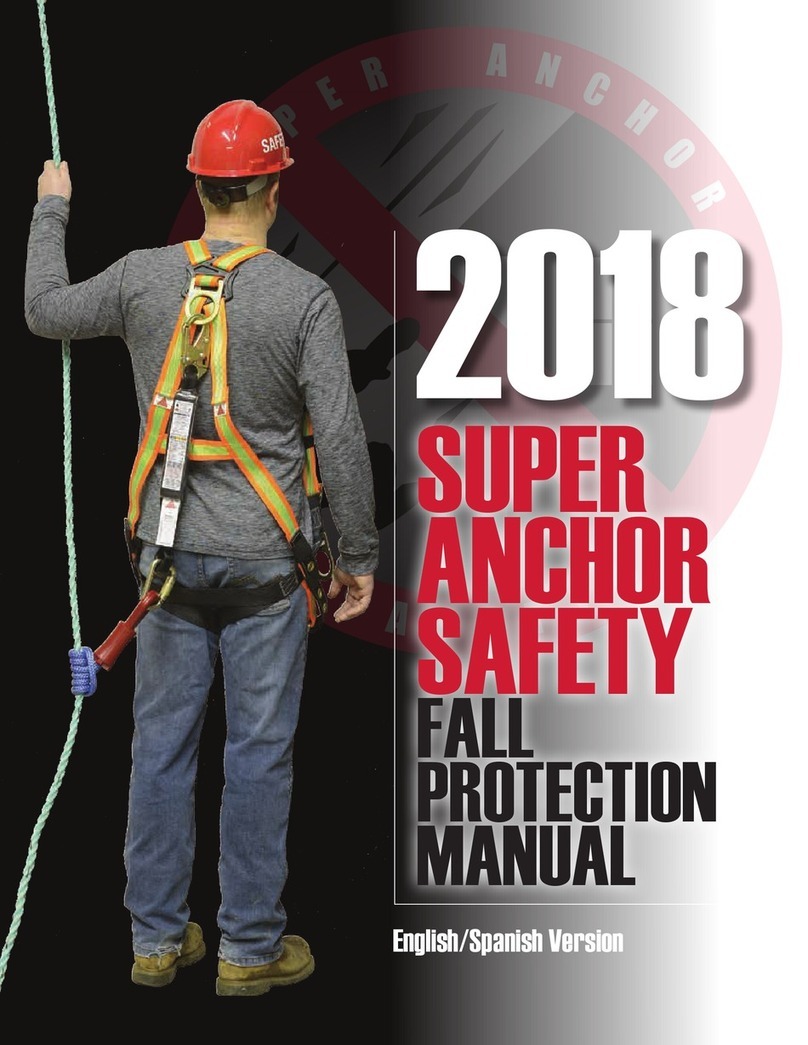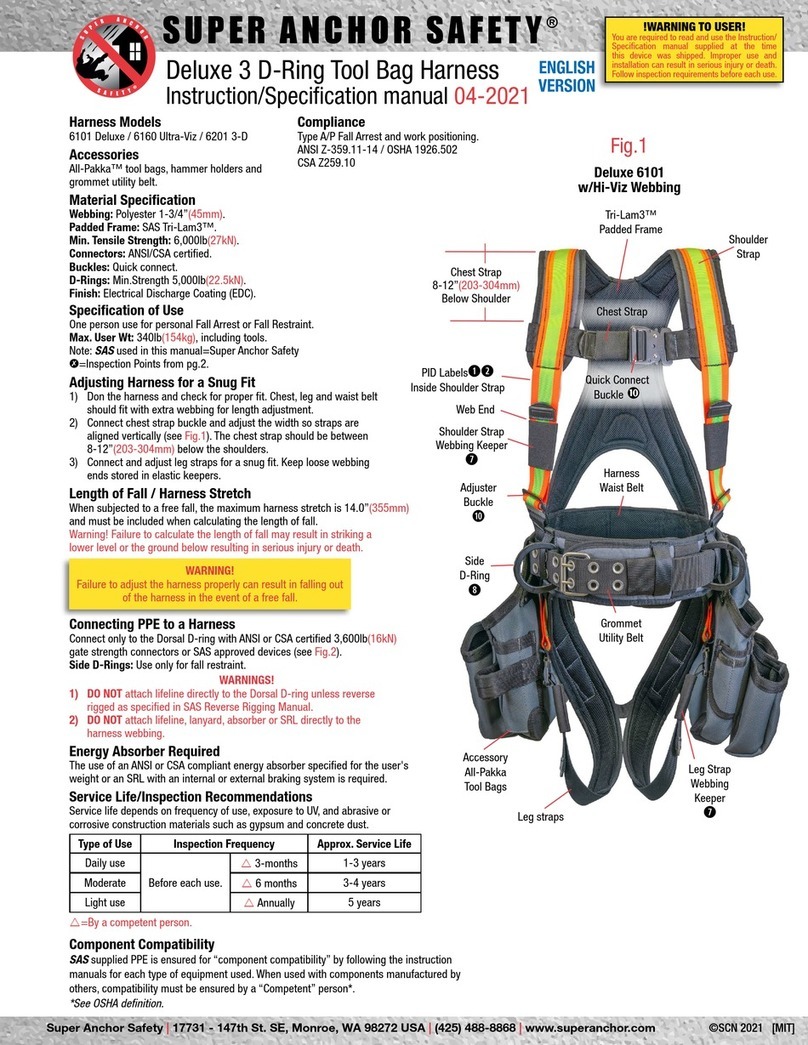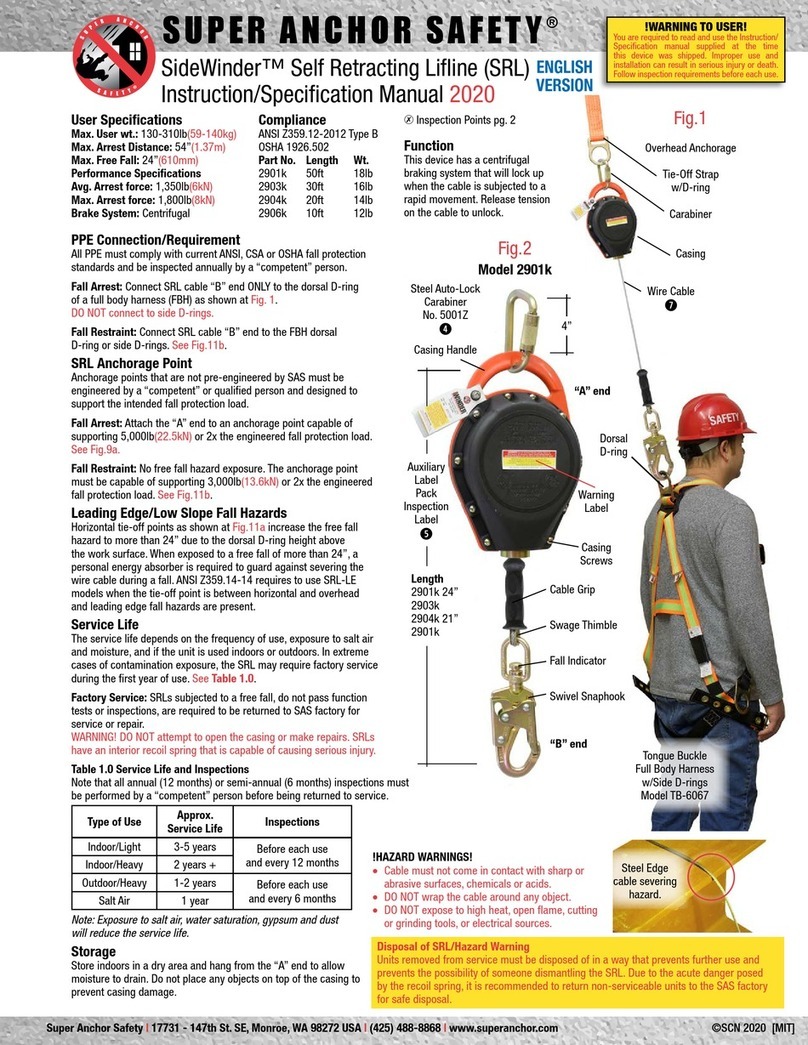ADJUSTING A
NEW HARNESS:
Hold the harness by the metal D-ring. Unbuckle the
chest strap and leg strap friction buckles. Remove any
twists in the webbing. Insert arms through the shoulder
straps so the D-ring is on your back and the arrow indi-
cator on the shoulder strap, shown in Fig. 3, is
pointing up toward your head. Leg straps should be
hanging down with no twists or tangles. Adjusting for
personal fit may require the harness to be put on and
taken off several times.
CHEST AND SHOULDER
STRAP ADJUSTMENT:
1. Align the shoulder straps so they are parallel to
each other as shown in Fig. 1. Buckle the chest strap
by inserting buckle "A" through buckle "B" as shown in
Figs. 5, 6 and 7below. Adjust the chest strap length by
moving the webbing through buckle "A" so the shoulder
straps do no extend past your armpits. For an average
size person the length between the shoulder straps
should be no more than 12". The chest strap should be
positioned at armpit level as shown in Fig. 1.
SECTION 1
HARNESS ADJUSTMENT AND COMPONENT CONNECTIONS
D-RING ADJUSTMENT:
3. The D-ring on harness back should position about the center of
the shoulder blades as shown in Fig. 2. Position the D-ring pad at
least 4" below the top of your shoulders but no more than 6". Adjust
the D-ring location by moving the webbing through the slots in the
D-ring pad (Fig. 3) and taking up excess webbing through the leg
strap friction buckles (Fig. 1). The chest strap position may have to be
adjusted after moving the D-ring pad.
4. Connect shock absorber as shown in Fig. 3 to the back of the
D-ring on the harness with the snaphook. Make sure the snaphook
functions properly by following instructions in Section 5-B.
5. Lifeline should be installed through the rope grab with the arrow
indicator pointing toward the anchor-point end of the lifeline shown in
Fig. 4. Follow the instructions for the rope grab adjustment in
Section 3 before use.
FRICTION BUCKLES:
7. Friction buckles are locked by inserting the smaller "A" buckle
through the larger "B" buckle (Fig. 5). Turn "A" buckle at an angle as
shown in Fig. 6 and slide through "B" buckle. The "A" buckle should
lay flat over the top of the "B" buckle as shown in Fig. 7.
LEG STRAP
ADJUSTMENT:
2. Buckle the leg straps and adjust for a snug
fit. Shorten or lengthen the strap by unbuck-
ling and moving the webbing through the "A"
buckle. Store excess webbing using keepers
shown in Fig. 7.
WEBBING KEEPERS:
8. Excess webbing from the chest and leg/shoulder straps are stored using the
plastic webbing keepers shown in Fig. 7. Webbing strap ends are terminated by
folding over and sewing in place. This prevents the webbing from sliding back
through the "A" buckle. For this reason, do not cut off excess webbing. If
termination overlap is missing do not use the harness.
WARNING:
IF THE HARNESS IS NOT ADJUSTED
FOR A SNUG FIT, IT IS POSSIBLE TO
COME OUT OF THE HARNESS IF YOU
FALL. THE CHEST STRAP MUST BE
CLOSED AND BUCKLED AT ALL
TIMES WHEN YOU ARE USING
THE HARNESS FOR FALL
PROTECTION.
Fig. 5 Fig. 6 Fig. 7
“A” “B”
Insert small buckle "A"
into large buckle "B" at an angle Buckle "A" lays over
the top of buckle "B"
Webbing
Keepers
"A" on top
Fig. 3
approx 12"
Adjust webbing
through D-ring
pad slots
D-ring pad
D-ring
Shoulder
strap arrow
Shock absorber
Fig. 1
Max length
below shoulder
6"
Harness
D-ring at
center of
back
Rope grab
Make sure "arrow" on
rope grab is pointed
toward anchorage point
6. Attach lifeline to anchorage device
with the snaphook. Ensure the snaphook
is locked and the lifeline is not twisted
or entangled.
Shoulder strap
Chest strap
position
(armpit height)
Leg strap
Friction buckles
NOTE: Shoulder strap webbing is adjusted by shortening
or lengthening the leg straps.
Fig. 4
Webbing overlap
Fig. 2
4


































